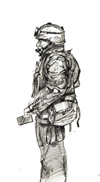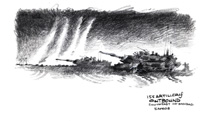 As 160,000 coalition troops stormed into Iraq last March, thirteen artists (some military, some civilian) were commissioned to depict coalition forces in action. WSJ.com (their link requires a paid subscription, so I am relying on pull quotes from other blogs) reported:
As 160,000 coalition troops stormed into Iraq last March, thirteen artists (some military, some civilian) were commissioned to depict coalition forces in action. WSJ.com (their link requires a paid subscription, so I am relying on pull quotes from other blogs) reported:
Sgt. Jack Carrillo and Staff Sgt. Michael Fay went for the U.S. Marine Corps. Their assignment: to depict fellow Marines in action. “During the tank battles, I was out there drawing,” Sgt. Carrillo says. “When you are out there and you’re under that duress, your art picks up a certain freshness and vibrancy.” On his second day in-country, “our Humvee flipped over in a night firefight and all my watercolors and paints were just trashed.” So he produced more than 200 pencil sketches depicting everything from slain enemy soldiers to the time “our whole battalion was food-poisoned in Baghdad.”
Here are all of the USMC Military sketches for Operation Iraqi Freedom.
 As Sylvain Galineau notes, any art with respect to the military is generally regarded with distain in most art circles, which only makes these artists more intriguing. Since I can’t read the article I can’t see the specific details but from what I understand, the civilians were outfitted in body armor and khakis, but were armed only with a paintbrush (or charcoal). These men risked their lives to produce art that is detested by most of their colleagues. I’m not too familiar with combat art like this, but this is truly intriguing.
As Sylvain Galineau notes, any art with respect to the military is generally regarded with distain in most art circles, which only makes these artists more intriguing. Since I can’t read the article I can’t see the specific details but from what I understand, the civilians were outfitted in body armor and khakis, but were armed only with a paintbrush (or charcoal). These men risked their lives to produce art that is detested by most of their colleagues. I’m not too familiar with combat art like this, but this is truly intriguing.
Apparently, combat art has been around since people began using the burnt end of a stick on cave walls to recount their hunting exploits for future generations. Since then, combat art has depicted WWII and Vietnam, and I’m sure countless other conflicts.
Sgt. Jack Carrillo actually commented at Chicago Boyz and left a link to all USMC Military sketches from the war, which look great. I did some other checking around, and I found this pdf article which also mentions Carrillo and provides a brief introduction to combat art…Generally, the task of capturing combat events in a visual form is left to cameras (which were also active during Iraqi Freedom), but Operation Iraqi Freedom was the first time an active-duty Marine was assigned to a combat zone with the explicit mission of capturing combat events on paper with graphite and charcoal. [thanks to Chicago Boyz for peaking my interest]